20386_Science_with_STEM_Year_4_Earth_and_Space_Sciences_Surface_changes
You also want an ePaper? Increase the reach of your titles
YUMPU automatically turns print PDFs into web optimized ePapers that Google loves.
<strong>Earth</strong> <strong>and</strong> space sciences<br />
SURFACE CHANGES<br />
Lesson 4<br />
Lesson plan<br />
Introduction:<br />
1. Review weathering from the previous lesson, including what weathering is <strong>and</strong> the different types.<br />
What are some examples? C<br />
2. What are some common l<strong>and</strong>forms? Use Google <strong>Earth</strong> to zoom<br />
in on l<strong>and</strong>forms such as the Gr<strong>and</strong> Canyon in Nevada, Santa Elena Canyon <strong>and</strong> Rio Gr<strong>and</strong>e River<br />
on the border of Mexico <strong>and</strong> USA, <strong>and</strong> Uluru in the Northern Territory. Click on any photographs of<br />
the l<strong>and</strong>forms to get another perspective. Students use a think-pair-share to answer the following<br />
questions: Do you think these l<strong>and</strong>forms are the result of weathering? What else could it be? Have<br />
you heard of erosion? What do you think it might mean? QP<br />
Development:<br />
3. Individually or in pairs, students use an iPad ® to scan the QR code on page 94 <strong>and</strong> watch a video<br />
about weathering <strong>and</strong> erosion. Students then answer the questions on page 94. This may also be<br />
done as a whole class activity. PC C<br />
4. In small groups, students conduct three experiments to demonstrate erosion by wind, water <strong>and</strong><br />
ice, using page 95. Each group collects the materials they will need to conduct each experiment<br />
<strong>and</strong> follows the procedure. Ensure groups take photographs before <strong>and</strong> after each experiment <strong>and</strong><br />
discuss the questions listed for each experiment. Students record their group’s response using an<br />
application like YAKiT or Chatterbox. Note: The ‘glacier’ will need to be prepared the night before<br />
by freezing water in a small takeaway container. PC PA C<br />
Differentiation<br />
• Less capable students can work together in a group, <strong>with</strong> teacher assistance.<br />
• More capable students can change some variables <strong>and</strong> conduct additional tests, such as altering<br />
the amount of water flow in the water erosion experiment, or adding rocks to the s<strong>and</strong> in the<br />
glacier erosion experiment.<br />
5. Individually, students watch a video of each type of erosion by typing the URL into a web browser<br />
or scanning the QR codes on page 96. Students compare their results to the information in the<br />
videos, writing about any differences or similarities. Alternatively, they may wish to draw a Venn<br />
diagram to represent the differences <strong>and</strong> similarities. PC PA E C<br />
Reflection:<br />
6. Individual students write on a mini whiteboard the difference between weathering <strong>and</strong> erosion.<br />
C<br />
7. As a class, play a few rounds of the interactive game ‘Shape it up’ at ,<br />
to solidify the concepts of erosion <strong>and</strong> weathering <strong>and</strong> how they create l<strong>and</strong>forms over long<br />
periods of time. C<br />
©R.I.C. Publications<br />
Low Resolution Images<br />
Display Copy<br />
R.I.C. Publications® – www.ricpublications.com.au YEAR <strong>Science</strong>:<br />
4 A <strong>STEM</strong> APPROACH 93


















